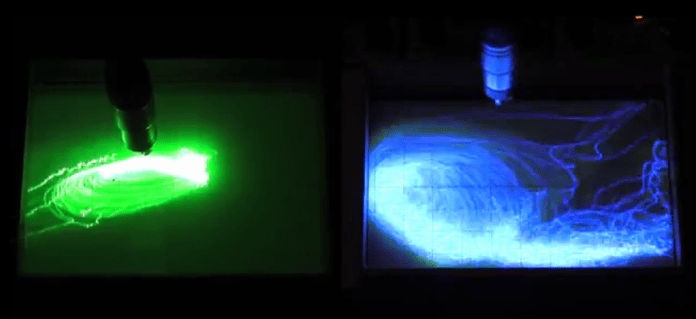Two turntables and a microphone? Try two oscilloscopes and a couple of photodiodes. [dfiction] reinterpreted Steve Reich’s classic feedback piece for more modern electronics. The video is embedded after the break.
The original Pendulum Music is a conceptual musical composition from the heady year of 1968. Basically, you set a bunch of microphones swinging across speakers, making feedback as they pass by. The resulting rhythmic and tonal oscillations change over time as the swinging damps down. It’s either mesmerizing or entirely boring, depending on your mindset.
In the [dfiction] version, the feedback is produced by passing a “light microphone” over an oscilloscope. And since he’s got a pair of these setups, the one microphone also feeds the other ‘scope. The resulting sound is this chaotic and gritty noise-rumble. We dig it.
If slowly evolving “process music” pushes the boundaries of your attention span (or if it’s just not your thing) you can totally skip around in the video. Try around 1:40 and 3:45 into the piece just to get an idea of what’s going on. But once you’re there, you might as well let it run its course.
For other DIY electro-music explorations, check out [dfiction]’s website. Also check out his Tinnitus Suites project on Vimeo.

















What about making the pendulums perform lissajous figures to get a little more variation?
That’s what I was hoping to see. Hearing the harmonics created by physical motion would be much more interesting than what felt like random noise.
This is an example of a math function for random. I can’t remember it’s name but one function serves as in input for the other and vice verse in such a way that it cannot oscillate. The result in a random (white noise) output. In this video there would be a lot of output that simply doesn’t fall into a hearing range.
Though it is not clear what is producing the audio, it sounds more like a square wave oscillator than the sine waves produced by natural feedback. Still an interesting “update” of the piece.
Looks similar to the alien retransmission on the movie “Contact”(1997).
This is awesome! I want to incorporate something similar into my Lunetta CMOS noise machine.
Seems to me you could get something similar (or maybe completely different) with a newton’s cradle and a simple noise circuit.
Apparently I’m not that artsy…
The one on the right kinda looks like an attractor.